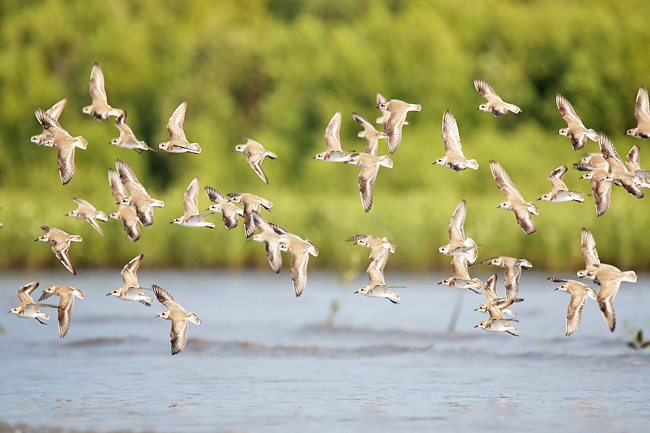Danial Norjidi
World Migratory Bird Day is held as an annual awareness-raising campaign, putting the spotlight on the need for the conservation of migratory birds and their habitats.
The observance is held on two days each year, with this year’s celebration being marked on May 13 and October 14. According to the World Migratory Bird Day website, the two days “reflect the cyclical nature of bird migration as well as the fact that there are varying peak migration periods in the northern and southern hemispheres”.
The theme for this year’s celebration is ‘Water: Sustaining Bird Life’, with focus on water and its importance to migratory birds, as well as the increasing threats to both water quality and quantity.
In a press statement in conjunction with World Migratory Bird Day, Executive Director of the Association of Southeast Asian Nations (ASEAN) Centre for Biodiversity (ACB) Dr Theresa Mundita S Lim said, “Water sustains all forms of life. It is essential for human needs such as drinking, proper nutrition, and sanitation; for the growth of crops and livestock, to maintain the operation of industries, and to preserve our natural ecosystems and all forms of wildlife including migratory waterbirds that feed, nest, and drink in wetlands.
“Despite the myriad of benefits derived from water resources, aquatic ecosystems around the world face severe threats caused by anthropogenic activities exacerbated by climate change. Rivers, lakes, aquifers, and wetlands that constitute freshwater ecosystems that only account for less than three per cent of the world’s water, an alarming figure that could threaten human survival, natural environment, and wildlife.”

Dr Lim highlighted that this year’s World Migratory Bird Day theme, the ACB joins the global community in amplifying the call for protecting and conserving freshwater ecosystems not only for human survival but equally so for biodiversity and the sustenance of wildlife, especially migratory waterbirds that serve as bioindicators of ecosystem health.
The executive director shared that inland waters and wetlands in the ASEAN region span a total of about two million square kilometres, comprising 60 per cent of the world’s tropical peatlands and 42 per cent of the global mangrove forests. “This vast amount of wetland resources and their ecosystem functions are yet to be widely acknowledged as a response to the increasing demand for clean water and as nature-based solutions to the impacts of climate change and biodiversity loss,” she said.
Well-managed wetlands can help protect the quality and quantity of water needed by all species, she continued. “In times of extreme weather conditions resulting from climate change, inland waters can serve as natural reservoirs as these ecosystems recharge groundwater and provide additional supply of surface water during rainy seasons. By absorbing excess nutrients and filtering pollutants, wetlands contribute to halting species extinction by providing healthy habitats for all wildlife to thrive. Mangroves and vegetation in riverbank serve as shield from flooding and erosion and mitigate their effects to communities on land.”
Dr Lim shared that several programmes to rehabilitate forests and wetlands in the region have been conducted by ASEAN, in line with the United Nations Decade on Ecosystem Restoration.
“Through the ACB, support to important wetlands and protected areas has been established in terms of capacity development programmes, livelihood development, and strict enforcement of regulations through one of the flagship programmes of the ACB – the ASEAN Heritage Parks (AHPs).”
Another regional initiative she mentioned was the ASEAN Flyway Network (AFN), which she described as a virtual network of national focal points, flyway site managers, and significant partners and stakeholders in the region.
“The AFN was created to enable coordinated conservation actions and international knowledge sharing and cooperation for the protection and conservation of the region’s wetlands and migratory birds. The activities supported by the AFN helped address knowledge gaps including the identification of potential flyway sites and wetlands of international importance or Ramsar sites”.
“The ASEAN is also taking particular attention on urban wetlands to address the challenges of population density in urban areas and improving the quality of urban waters. Studies revealed that almost 70 per cent of the world’s population will settle in cities and urban areas by 2050, and this is expected to put tremendous pressure on wetlands to provide the required demand for clean water.”
According to the executive director, among the 55 ASEAN heritage parks, urban wetlands are found to be currently under-represented; and as a response, integration of urban wetlands into the AHP Network through the updating of the AHP Regional Action Plan is now being done by the ACB as programme secretariat.
Two urban wetlands are now considered as pilot sites for this Action Plan namely, the Nong Kham Sen Wetland in Lao and Bang Pu Nature Education Centre in Thailand.
Dr Lim also highlighted that the survival of over 50 million migratory waterbirds from over 250 different populations that fly along the East Asian-Australasian Flyway depend on healthy and productive wetlands in the region.
“Hence, a more inclusive and assertive regional stand is necessary to deal with the global water crisis and safeguard these ecosystems from which the migratory species depend.
“National governments must implement relevant policies to effectively manage the freshwater sources with a healthy balance of ecosystem protection and economic considerations guided by the principles of sustainable development.”
She stated that the adoption of nature-based solutions in development planning, continuous research on freshwater resources, and developing ecologically-friendly hydrologic technologies are indispensable to fully utilise the benefits that nature can provide.
“Suffice to say the least, all of the mentioned actions and interventions in the region can only be fully realised through cross-border collaboration and flyway-scale conservation. Full cooperation of the ASEAN member states in the AFN, the East Asian-Australasian Flyway Partnership (EAAFP), and linkages with the other major flyways are needed to amplify our message of migratory bird conservation to the rest of the world and to ensure that specific threats to the ASEAN freshwater ecosystems are addressed with relevant and holistic action plans with a high chance of successful implementation,” added Dr Lim.




